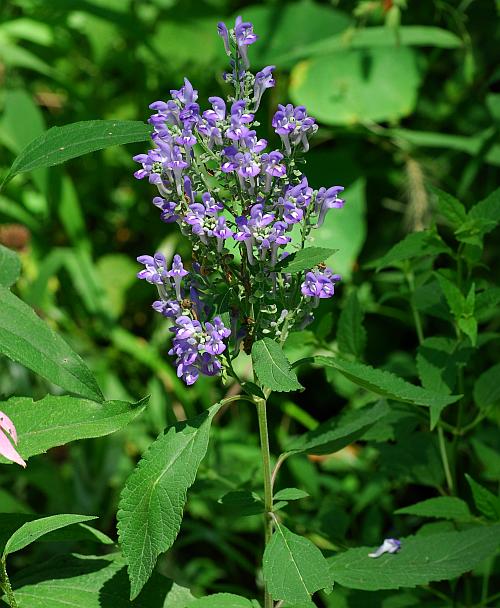Scutellaria incana Biehler
Downy Skullcap

Native
CC = 5
CW = 5
MOC = 54
© SRTurner
Scutellaria incana BiehlerDowny Skullcap | |
 |
Native CC = 5 CW = 5 MOC = 54 |
© SRTurner |
|
Family - Lamiaceae Habit - Perennial forb, sometimes with short rhizomes. Stems - Ascending to erect, to 80 cm, single or multiple from the base, sometimes from a short, spreading base, unbranched or occasionally few-branched, 4-angled, densely pubescent with short, upward-curved, nonglandular hairs, often also with sessile glands.
Leaves - Opposite, simple, petiolate. Petioles 5-30 mm long, winged toward the tip. Leaf blades 4-11 cm long, ovate to elliptic, angled or tapered at the base, those of the lowermost leaves occasionally asymmetrically rounded or shallowly cordate (but with a wedge of tissue in the notch extending down the petiole tip), angled or tapered to a sharply pointed tip, the margins finely to occasionally coarsely and more or less bluntly toothed, the upper surface green and sparsely to moderately pubescent with minute, curved, nonglandular hairs, mostly along the main veins or toward the blade base, the undersurface grayish green and moderately to densely pubescent with short, curved and more or less straight, nonglandular hairs, more densely so along the veins, both surfaces also with sessile glands.
Inflorescence - Dense racemes, mostly terminal, sometimes in a cluster of 3 from the stem tip, the flowers 2 per node, solitary in the axils of bracts, the bracts 4-6 mm long, narrowly elliptic to lanceolate, reduced upwards and becoming linear. Axis of racemes 4-angled, green, densely tomentulose. Pedicels to 3mm long, pubescent.
Flowers - Calyces 2-3 mm long, becoming closed and enlarged to 5-6 mm at fruiting, with a a short transverse dorsal protuberance, the outer surface densely pubescent with short, appressed to somewhat woolly, nonglandular hairs, sometimes also with sessile glands. Corollas zygomorphic, bilabiate, 15-25 mm long, moderately to densely pubescent with minute, appressed to somewhat woolly, nonglandular hairs on the outer surface, often also with sessile glands, blue to bluish purple or purple above a usually white tube, the lower lip with a white patch toward the base, the tube S-shaped (bent upward just above the calyx and strongly curved or oblique at or above the throat), with a ring of hairs in the throat, the lateral lobes relatively well-developed, ascending, the lower lip broadly fan-shaped to nearly semicircular, usually shallowly notched at the tip. Stamens 4, didynamous, included under the galea of the upper lip, adnate to the corolla tube near the "hinge" of the flower. Free portion of the filaments to 1 cm long, white to lilac, pilose in the basal 1/2, glabrous apically. Anthers to 2mm long, purple when fresh, with a dorsal margin of dense pilose hairs. Style inserted between the stamens, included under the galea, whitish, glabrous, uncinate at the apex, to 2.5 cm. Ovary superior, deeply 4-lobed, the lobes globose, green, glabrous, 0.4 mm in diameter in flower, arranged in an "auditorium seat" fashion with one pair of lobes higher than the other pair. All lobes resting on a large nectary. Nectary with whitish glands.
Fruits - Nutlets 1-4 per calyx, 1.5-2.0 mm long, more or less globose, the surface dark brown, finely warty or with dense, low, rounded tubercles.
Flowering - June - September. Habitat - Forests, streambanks, fens, bluffs, ditches, roadsides. Origin - Native to the U.S. Lookalikes - S. ovata. Other info. - This striking species is most commonly found in the southern half of the state. From Missouri its range extends eastward, mostly in a broad band ending in eastern Pennsylvania. The plant is easily recognized as a species of Scutellaria by the uniquely shaped flowers, and by the small projection on the upper surface of the calyx. It resembles its lookalike S. ovata but typically has larger inflorescences and flowers with a light canescence (grayish color due to minute hairiness). Most of the leaves will lack cordate bases but instead be tapered. The flower corolla has a ring of hairs internally, near the region of the calyx. This feature is definitive but minute, and requires careful dissection of the flower to observe. Photographs taken near Stegal Mountain, Shannon County, MO., 6-28-03 (DETenaglia); also at Young Conservation Area, Jefferson County, MO, 7-27-2013, and Shaw Nature Reserve, Franklin County, MO, 7-20-2017 and 8-4-2021 (SRTurner). |